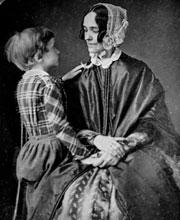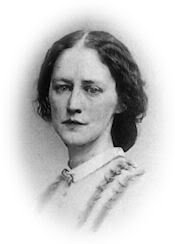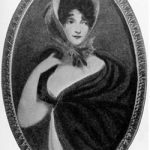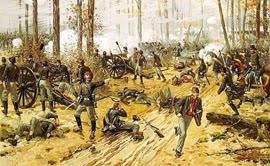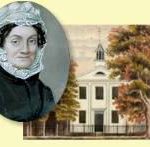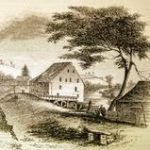15th First Lady of the United States
Jane Pierce (1806–1863), wife of 14th President Franklin Pierce, was First Lady of the United States from 1853 to 1857. She hated public life and society, but married a man whose passion was politics. She was refined, well-educated and religious, but her life is generally remembered as a series of tragedies.
Image: Jane Pierce and her beloved son Benny
Jane Appleton was born on March 12, 1806 in Hampton, New Hampshire, the daughter of Elizabeth Means Appleton and Reverend Jesse Appleton, a Congregationalist minister. Jane was a petite, frail, shy and melancholy figure. After the death of her father, who had served as president of Bowdoin College in Brunswick, Maine, Jane moved into the mansion of her wealthy maternal grandparents in Amherst, New Hampshire at age 13.
Marriage and Family
It is unclear exactly how Jane met Franklin Pierce, a young lawyer with political ambitions, but her brother-in-law Alpheus Packard, one of Pierce’s professors at Bowdoin College in Brunswick, Maine might have introduced them. Jane’s family objected to Pierce’s political ambitions, and opposed her marriage to the future President.
Jane Appleton married Franklin Pierce on November 19, 1834, at her grandmother’s home in Amherst. Jane was 28; Franklin was almost 30. The couple honeymooned six days at a boardinghouse near Washington, DC, where Franklin was a member of the U.S. House of Representatives. She was not impressed with the capital and was offended by the drinking and the sordid nature of politics.
However, her early letters to her in-laws and to her mother indicate that she at least attempted to perform the obligations of a Congressman’s wife. On occasion she would show great insight into the motives and characters of her husband’s fellow politicians. Abhorring the Washington social scene, Jane often used her fragile health as an excuse to decline many invitations.
When her health worsened in 1835, Jane left the city to recuperate with her mother in New Hampshire – the first of many separations from her husband. The death of her first child, Franklin Pierce, Jr. in 1836, three days after he was born, exacerbated Jane’s health, as did news that her husband was remaining in Washington, DC, to serve in the U.S. Senate.
Reclusive and prone to deep depressions, Jane Pierce would never be able to accept her husband’s political career or to mingle easily in society. She leaned heavily on female family members for support, particularly her aunt Abigail Kent Means and her eldest sister Mary Appleton Aiken. Fortunately, Jane had a husband who permitted her the freedom to visit her relatives whenever she liked.
Jane Pierce, a devout Congregationalist, soon became convinced that her husband’s political career had roiled an angry God against his family, causing the death of their infant son. She blamed Franklin’s political life for everything that went wrong with the family, including his excessive drinking. She reluctantly joined her husband in the nation’s capital but pressured him to pursue another career.
In 1842, Pierce resigned his Senate seat and returned to New Hampshire, where he practiced law in Concord. The birth of a third son, Benjamin Pierce, and her husband’s promise to stay out of politics provided Jane with some relief, but Pierce’s retirement from the Senate was rewarded with more death when their second son, Franklin Robert, died of typhus in 1843 at the age of four.
To honor his promise to his wife, Franklin Pierce refused the nomination for Governor of New Hampshire. He also declined the appointment as U.S. Attorney General under President James K. Polk, and promised to have his name removed from the list of possible presidential candidates for the Democratic Party.
Pierce became a local hero for his service in the Mexican-American War (1846-1848). He returned home safely, and for four more years the Pierces lived quietly at Concord, New Hampsire, in the happiest period of their lives, where Jane relaxed and watched their son Benjamin ‘Benny’ grow up.
However, Franklin Pierce became the compromise presidential candidate on the thirty-fifth ballot at the Democratic Party convention in 1852, which he had assured his wife was highly unlikely. Jane fainted when she received the news. When Pierce took Jane to Newport for a brief rest, eleven-year-old Benny wrote to her: “I hope he won’t be elected for I should not like to be at Washington and I know you would not either.”
Jane quietly prayed that her husband would lose the election, but he eventually convinced his wife that being a president’s son would be an asset for Benny in the future. When Pierce was elected president in the fall of 1852, Jane reluctantly made plans to move to Washington.
In January 1853 the Pierce family embarked on a journey by rail to Boston. During their return trip, a coupler on the train failed and threw several cars down a snowy embankment. Jane and Franklin received only bruises and scratches, but 11-year-old Benny Pierce’s head was crushed and partly severed right before their eyes. He died instantly, the only fatality in the accident. Jane never recovered from the tragedy.
First Lady (1853-1857)
Jane Pierce learned shortly before his inauguration that her husband had not been an unwilling nominee, but had actively pursued the presidential nomination. Knowing that neither his wife nor his son wanted to move to Washington, Pierce had still encouraged friends to submit his name when the Democrats could not decide between four candidates.
Realizing that she had been deceived, Jane was overwhelmed with resentment and distanced herself from her husband during his presidency. She did not attend his inauguration and refused to appear at the White House for several weeks thereafter. When she finally arrived, she draped the state rooms in mourning bunting and abdicated her duties as hostess. When a spouse, parent or child died, it was customary to drape the home in black, cover mirrors and refrain from social gatherings
The mourning customs of the time also dictated Jane’s dress and behavior during the first two years of Pierce’s presidency. Deep mourning lasted approximately one year, with an additional nine months of full or second mourning, and three to six months of half mourning. During deep mourning, a woman dressed in heavy black clothing without ornamentation and wore a full black veil when out in public.
While in deep mourning, a woman would not take part in social events other than those necessary for the continued well-being of the family. Jane’s period of mourning lasted a full two years. She seems to have found the additional time necessary, perhaps in order to find relief from the pressure of social events.
After first arriving at the White House the First Lady retired to her room, where she spent her days writing heartbreaking letters of apology to her deceased son:
My precious child – I must write to you, altho’ you are never to see it or know it – How I long to see you and say something to you as if you were as you always have been (until these last three dreadful weeks) near me. …my dear son, how much I feel my own faults in regard to you – I know that I did not take the right way and should have dealt with you very gently often when I judged hastily and spoke harshly. I can see that I was ‘unreasonable’ and sometimes almost wonder that you loved me at all. God help me now to correct in bitterness my errors…
It is too late for you to have the sweet benefit of it – and now this Sabbath evening you will come in fancy before me and I sit close by you, with your hand in mine perhaps, or you will lean against me on the sofa, or as sometimes you did on Sunday evening sit on my lap a little while and we talk together and say hymns and then play and then by and by you go to bed first putting your arms around me and laying your dear head on my shoulder and then you get in your bed and we have our Sabbath night kiss – but to think I can never have another – Oh Benny, I have not valued such a sweet blessing as I ought.
Weeks after her husband became President, the previous First Lady Abigail Fillmore passed away and Vice President William King died of tuberculosis the following month, adding to Pierce administration’s aura of gloom. During her tenure at the White House, Jane’s depression and grief were so evident to all that Franklin’s friend, author Nathaniel Hawthorne, referred to her as “that death’s head in the White House.”
Jane’s aunt Abigail Kent Means handled the First Lady’s social responsibilities. Since Mrs. Means had no children, she found it easier to spend long periods of time with Jane, whom she loved like a sister. When Mrs. Means was absent from the Capitol, Varina Davis (wife of the Secretary of War and future First Lady of the Confederacy) officiated.
As time passed, Jane Pierce gradually became more involved in her husband’s life making her first official appearance as First Lady at a New Year’s Day reception in 1855 and thereafter served intermittently. But her health and her disinterest in Washington society made her unable and unwilling to embrace the full responsibilities of the role. She did attend Congressional debates, which is surprising considering her dislike of politics.
Having more of an abolitionist background than her husband, it was Jane Pierce who persuaded him to release Dr. Charles Robinson, an ardent abolitionist and republican, from a Kansas prison where he had been detained. Pierce, known for his kindness of heart, did so both for his wife and the distraught wife of Dr. Robinson.
The Pierces were responsible for making several modern and decorative changes to the White House, including a furnace, a tile-covered bathroom with hot and cold running water, a new rug in the East room, new ornate mirrors (still being used) and a handsome china service which the President purchased at the New York World’s Fair.
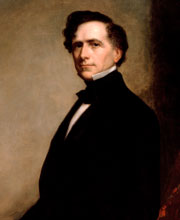
Image: President Franklin Pierce
Pierce’s presidency was less than successful and his party did not nominate him for a second term. Almost immediately after the election of James Buchanan in 1856, the Pierces moved out of the White House so the staff could prepare the house for the incoming president and his niece Harriet Lane, who would serve as First Lady. Franklin Pierce remembered that when he entered the presidential mansion no arrangements had been made for him – he and his secretary ended up sleeping on chairs the first night.
Later Years
By the time they left the White House in 1856, Jane’s grief had taken a toll on her health, physically and mentally. After leaving Washington, the Pierces spent a short period of time in New England – Franklin in New Hampshire to settle accounts, Jane in Andover, Massachusetts with her sister Mary Aiken.
Pierce tried to raise his wife’s spirits by taking her on an extended cruise to the Caribbean aboard the U.S.S. Powhatan, a government ship loaned to them by President Buchanan. From the Caribbean they sailed to Europe, where Franklin made a valiant attempt to help his wife recover, but she contracted tuberculosis during the trip.
The Pierces returned to the United States in 1860, and Jane rarely left her sister’s home in Andover, Massachusetts after that. Her worsening disease soured their remaining years together. During the Civil War, the Pierces were divided. Franklin was all for preserving the Union while Jane hoped for an end to slavery, even if it took a war and breaking up the Union to do so.
Jane Pierce died at her sister Mary Aiken’s home in Andover, Massachusetts on December 2, 1863 at age 57. The ex-president took his wife home to Concord, New Hampshire to be buried beside their sons.
Franklin Pierce spoke often of going and watering the flowers “on the sacred spot.” He began drinking heavily after the death of his wife and that of his best friend Nathaniel Hawthorne in 1864. He drank himself to death in 1869 and was buried beside his family members at Old North Cemetery in Concord.
Shy, sad, and fragile in both body and mind, Jane Pierce resembled the heroine of a Victorian novel. She is often a forgotten figure among the First Ladies of the United States.
SOURCES
NNDB: Jane Pierce
Wikipedia: Jane Pierce
Miller Center: Jane Pierce
First Lady Biography: Jane Pierce
